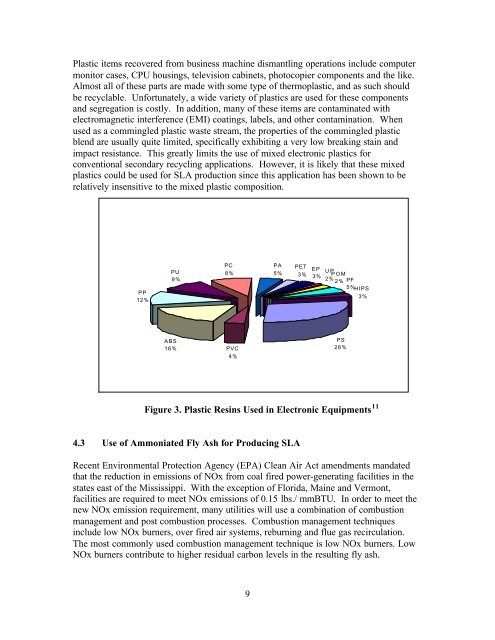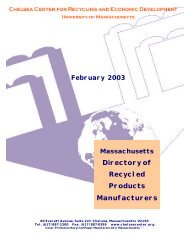fly ash/plastic synthetic aggregate for construction material
fly ash/plastic synthetic aggregate for construction material
fly ash/plastic synthetic aggregate for construction material
You also want an ePaper? Increase the reach of your titles
YUMPU automatically turns print PDFs into web optimized ePapers that Google loves.
Plastic items recovered from business machine dismantling operations include computer<br />
monitor cases, CPU housings, television cabinets, photocopier components and the like.<br />
Almost all of these parts are made with some type of thermo<strong>plastic</strong>, and as such should<br />
be recyclable. Un<strong>for</strong>tunately, a wide variety of <strong>plastic</strong>s are used <strong>for</strong> these components<br />
and segregation is costly. In addition, many of these items are contaminated with<br />
electromagnetic interference (EMI) coatings, labels, and other contamination. When<br />
used as a commingled <strong>plastic</strong> waste stream, the properties of the commingled <strong>plastic</strong><br />
blend are usually quite limited, specifically exhibiting a very low breaking stain and<br />
impact resistance. This greatly limits the use of mixed electronic <strong>plastic</strong>s <strong>for</strong><br />
conventional secondary recycling applications. However, it is likely that these mixed<br />
<strong>plastic</strong>s could be used <strong>for</strong> SLA production since this application has been shown to be<br />
relatively insensitive to the mixed <strong>plastic</strong> composition.<br />
PP<br />
12%<br />
PU<br />
9%<br />
PC<br />
8%<br />
PA<br />
5%<br />
PET<br />
3% EP<br />
3% UP<br />
2% POM<br />
2% PF<br />
5%HIPS<br />
3%<br />
ABS<br />
16%<br />
PVC<br />
4%<br />
PS<br />
28%<br />
Figure 3. Plastic Resins Used in Electronic Equipments 11<br />
4.3 Use of Ammoniated Fly Ash <strong>for</strong> Producing SLA<br />
Recent Environmental Protection Agency (EPA) Clean Air Act amendments mandated<br />
that the reduction in emissions of NOx from coal fired power-generating facilities in the<br />
states east of the Mississippi. With the exception of Florida, Maine and Vermont,<br />
facilities are required to meet NOx emissions of 0.15 lbs./ mmBTU. In order to meet the<br />
new NOx emission requirement, many utilities will use a combination of combustion<br />
management and post combustion processes. Combustion management techniques<br />
include low NOx burners, over fired air systems, reburning and flue gas recirculation.<br />
The most commonly used combustion management technique is low NOx burners. Low<br />
NOx burners contribute to higher residual carbon levels in the resulting <strong>fly</strong> <strong>ash</strong>.<br />
9




